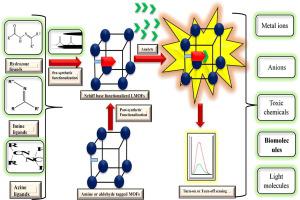Coordination Chemistry Reviews ( IF 20.6 ) Pub Date : 2021-09-16 , DOI: 10.1016/j.ccr.2021.214214 Manpreet Kaur 1 , Sanjay Kumar 2 , M. Yusuf 1 , Jechan Lee 3 , Richard J.C. Brown 4 , Ki-Hyun Kim 5 , Ashok Kumar Malik 1

|
Luminescent metal–organic frameworks (LMOFs) are porous crystalline materials consisting of metal clusters and organic linkers. Although LMOFs belong to a subcategory of MOFs, they are superior to typical MOFs in many ways (e.g., in terms of photostability, sensing ability, ease of use, interactions with target analytes, and rapid detection mechanisms). Schiff bases with various desired functionalities can be incorporated into the pore cages of LMOF materials via pre- and post-synthetic modifications. Such functionalities can be used to favorably provide active sites for the selective detection of various target components (e.g., metal ions, anions, biomolecules, explosives, gases, and light molecular weight solvent molecules). This work reviews the recent progress achieved in the development of Schiff base-functionalized LMOF sensors for diverse target substances based on state-of-the-art approaches available for their synthesis.
中文翻译:

用于生物和化学传感的希夫碱配合物对发光金属有机骨架的合成后修饰
发光金属有机骨架(LMOF)是由金属簇和有机连接体组成的多孔结晶材料。尽管 LMOF 属于 MOF 的一个子类别,但它们在许多方面都优于典型的 MOF(例如,在光稳定性、传感能力、易用性、与目标分析物的相互作用和快速检测机制方面)。具有各种所需功能的席夫碱可以通过合成前和合成后的修饰结合到 LMOF 材料的孔笼中。此类功能可用于有利地提供用于选择性检测各种目标成分(例如,金属离子、阴离子、生物分子、爆炸物、气体和轻分子量溶剂分子)的活性位点。


























 京公网安备 11010802027423号
京公网安备 11010802027423号